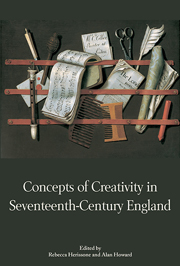Book contents
- Frontmatter
- Contents
- List of Illustrations
- List of Contributors
- Preface
- Introduction
- Creating to Order: Patronage and the Creative Act
- Creative Identity and the Role of Print Media
- Mapping Knowledge: The Visual Representation of Ideas
- 5 Space, Text and Creativity in the Late Sixteenth and Seventeenth Centuries
- 6 The ‘Artificial Sceane’: The Re-creation of Italian Architecture in John Evelyn's Diary
- Authorial Identity
- Imitation and Arrangement
- The Performer as Creator
- Bibliography
- Index
5 - Space, Text and Creativity in the Late Sixteenth and Seventeenth Centuries
from Mapping Knowledge: The Visual Representation of Ideas
Published online by Cambridge University Press: 05 March 2014
- Frontmatter
- Contents
- List of Illustrations
- List of Contributors
- Preface
- Introduction
- Creating to Order: Patronage and the Creative Act
- Creative Identity and the Role of Print Media
- Mapping Knowledge: The Visual Representation of Ideas
- 5 Space, Text and Creativity in the Late Sixteenth and Seventeenth Centuries
- 6 The ‘Artificial Sceane’: The Re-creation of Italian Architecture in John Evelyn's Diary
- Authorial Identity
- Imitation and Arrangement
- The Performer as Creator
- Bibliography
- Index
Summary
Introduction
Creation: a making or forming of something, as it were, out of nothing Edward Phillips, The New World of Words
Edward Phillips's attempt to define creation in 1671 highlights a number of issues that are central to developments in thinking about creativity, knowledge and artistic innovation during the seventeenth century. His idea of creating ‘something’ from ‘nothing’ implies, at one level, absolute novelty: a lack of precedence, a complete rupture with and effacement of a past state or experience; something appears where once there was emptiness or blankness. Simultaneously, however, the emphasis on ‘making’ and especially ‘forming’ suggests that there are materials to be moulded: existing matter to be reshaped into something new; Phillips suggests that creation has to be made from something, even as this ‘some-thing’ is described as ‘no-thing’. This ambivalence – the ‘as it were’ in the definition – hints at the multiple concepts and interpretations of creativity that existed in the seventeenth century.
In the early modern period – particularly in the realm of epistemology – creation was understood both in terms of reshaping, translating and reconfiguring that which exists and as the production of fresh entities ‘out of nothing’. Seventeenth-century theories of creativity seem to emanate from precisely this tension between novelty and precedent, between the purity of the new and the foundation of the old.
- Type
- Chapter
- Information
- Concepts of Creativity in Seventeenth-Century England , pp. 107 - 130Publisher: Boydell & BrewerPrint publication year: 2013



